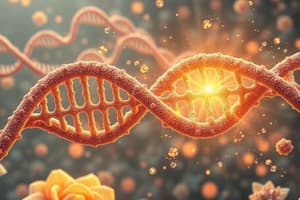Podcast
Questions and Answers
What does DNA stand for?
What does DNA stand for?
Deoxyribonucleic Acid
What is transcription in protein synthesis?
What is transcription in protein synthesis?
The process of copying DNA by RNA polymerase to create an mRNA molecule.
What does mRNA stand for?
What does mRNA stand for?
Messenger RNA
What is the nucleus?
What is the nucleus?
What is cytoplasm?
What is cytoplasm?
What does tRNA stand for?
What does tRNA stand for?
What is the function of a ribosome?
What is the function of a ribosome?
What is a polypeptide?
What is a polypeptide?
What are amino acids?
What are amino acids?
What is a codon?
What is a codon?
What is an anticodon?
What is an anticodon?
Where does transcription take place?
Where does transcription take place?
Where does translation occur?
Where does translation occur?
What is RNA polymerase?
What is RNA polymerase?
What does the central dogma theory describe?
What does the central dogma theory describe?
What is the process of transcription?
What is the process of transcription?
What is the process of translation?
What is the process of translation?
What are peptide bonds?
What are peptide bonds?
What are the base pairing rules for DNA to RNA during transcription?
What are the base pairing rules for DNA to RNA during transcription?
What are the RNA to RNA base pairing rules during translation?
What are the RNA to RNA base pairing rules during translation?
What is transcription?
What is transcription?
What is translation?
What is translation?
What is tRNA?
What is tRNA?
What is an anticodon?
What is an anticodon?
Flashcards are hidden until you start studying
Study Notes
Protein Synthesis Overview
- DNA (Deoxyribonucleic Acid): The genetic material located in the nucleus of eukaryotic cells.
- Transcription: The first step of protein synthesis; involves copying DNA into messenger RNA (mRNA) using RNA polymerase.
- mRNA (Messenger RNA): Acts as a copy of DNA’s instructions, crucial for protein synthesis.
- Nucleus: The control center of the cell, responsible for storing and managing DNA.
- Cytoplasm: Gel-like substance within cells where organelles are suspended and where translation occurs.
- tRNA (Transfer RNA): Delivers amino acids from the cytoplasm to the ribosome, essential for translating mRNA into proteins.
- Ribosome: An organelle that synthesizes proteins by following instructions carried by mRNA.
- Polypeptide: A chain of amino acids linked together, forming proteins.
- Amino Acid: The basic building blocks (monomers) of proteins.
- Codon: A sequence of three nucleotides on mRNA that codes for a specific amino acid.
- Anticodon: A sequence of three nucleotides on tRNA that pairs with a complementary codon on mRNA.
- Transcription Location: Occurs in the nucleus.
- Translation Location: Takes place in the cytoplasm on ribosomes.
- RNA Polymerase: The enzyme responsible for transforming DNA into RNA during transcription.
- Central Dogma Theory: Describes the flow of genetic information: DNA -> RNA -> Protein.
- Transcription: The process of synthesizing mRNA from a DNA template.
- Translation: The conversion of mRNA into a polypeptide chain according to genetic instructions.
- Peptide Bond: The chemical bond that links amino acids to form polypeptides.
- DNA to RNA Base Pairing Rules: In transcription, adenine pairs with uracil (A -> U), thymine pairs with adenine (T -> A), and cytosine pairs with guanine (C <-> G).
- RNA to RNA Base Pairing Rules: In translation, adenine pairs with uracil (A -> U) and cytosine pairs with guanine (C <-> G).
Studying That Suits You
Use AI to generate personalized quizzes and flashcards to suit your learning preferences.




